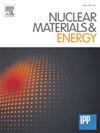Balmer emission measurements in JET-ILW hydrogen, deuterium, tritium and deuterium-tritium low-confinement mode plasmas
IF 2.7
2区 物理与天体物理
Q1 NUCLEAR SCIENCE & TECHNOLOGY
引用次数: 0
Abstract
Measurements of Balmer-alpha (B-α) and Balmer-gamma (B-γ), where B = H, D, or T isotopes of hydrogen, emission across the low-field side (LFS) divertor in JET ITER-like Wall (ILW), low-confinement mode (L-mode) plasma indicate that the divertor plasma was more strongly detached in deuterium, tritium and deuterium–tritium than in hydrogen plasmas. These measurements are consistent with the lower degree of detachment in hydrogen versus tritium plasmas inferred from Langmuir probes (Groth et al., 2023) [1]. The ratio of B-γ to B-α is a suitable indicator of high density/low temperature conditions because B-α emission is dominated by electron impact excitation with a small electron–ion recombination component regardless of electron temperature and density (for conditions in tokamak plasmas) whilst for B-γ the recombination component increases and the excitation component decreases as the electron temperature decreases and the electron density increases. Within the uncertainty of the measurements, the electron density at the low-field side separatrix and the power crossing the separatrix are similar to permit these comparisons. The B-©/B-α ratio is well correlated with the onset of detachment as measured by Langmuir probes (McCracken et al., 1998; Groth et al., 2023). The ratios of B-γ and B-α varied between 0.005 and 0.035 for low-recycling, high-recycling and partially detached conditions, and were 60–70 % higher in partially detached hydrogen than in tritium plasmas. In contrast, the difference between deuterium, tritium and 40–60 % deuterium–tritium is within 10 % and thus within the uncertainties of the measurements. Profiles of the B-α and B-γ emission was measured with two filtered CCDs connected to the visible lost light leg of JET’s mirror link spectroscopy system (Meigs et al., 2010; Lomanowski et al., 2014)[4,5]. Spatially (radial) narrower B-α profiles were measured with increasing isotope mass, while similarly broadened B-γ profiles were measured.
在JET-ILW氢、氘、氚和氘-氚低约束模式等离子体中的巴尔默发射测量
在JET ITER-like Wall (ILW)、低约束模式(L-mode)等离子体中,通过低场侧(LFS)分流器发射的巴尔默-α (B-α)和巴尔默-γ (B-γ)(其中B =氢的H、D或T同位素)的测量表明,氘、氚和氘-氚的分流器等离子体比氢等离子体更强烈地分离。这些测量结果与Langmuir探测器(growth et al., 2023)推断的氢等离子体与氚等离子体的分离程度较低一致。B-γ与B-α的比值是高密度/低温条件下的合适指标,因为B-α的发射主要受电子撞击激发的影响,与电子温度和密度无关(对于托卡马克等离子体),而B-γ的发射则随着电子温度的降低和电子密度的增加,复合成分增加,激发成分减少。在测量的不确定度范围内,低场侧分离矩阵处的电子密度和穿过分离矩阵的功率是相似的,可以进行这些比较。Langmuir探针测量的B-©/B-α比值与脱离的发生有很好的相关性(McCracken et al., 1998;growth et al., 2023)。在低循环、高循环和部分分离条件下,B-γ和B-α的比值在0.005 ~ 0.035之间,部分分离的氢等离子体比氚等离子体高60 ~ 70%。相反,氘、氚和40 - 60%氘-氚之间的差异在10%以内,因此在测量的不确定度之内。B-α和B-γ发射的轮廓是用两个过滤的ccd测量的,这些ccd连接到JET的镜像链接光谱系统的可见损失光腿(Meigs等,2010;Lomanowski et al., 2014)[4,5]。随着同位素质量的增加,B-α谱线在空间上(径向)变窄,而B-γ谱线则变宽。
本文章由计算机程序翻译,如有差异,请以英文原文为准。
求助全文
约1分钟内获得全文
求助全文
来源期刊

Nuclear Materials and Energy
Materials Science-Materials Science (miscellaneous)
CiteScore
3.70
自引率
15.40%
发文量
175
审稿时长
20 weeks
期刊介绍:
The open-access journal Nuclear Materials and Energy is devoted to the growing field of research for material application in the production of nuclear energy. Nuclear Materials and Energy publishes original research articles of up to 6 pages in length.
 求助内容:
求助内容: 应助结果提醒方式:
应助结果提醒方式:


